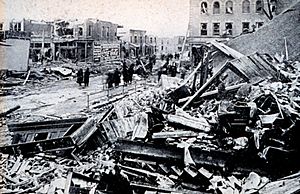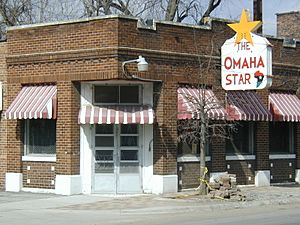Near North Side, Omaha facts for kids
The Near North Side of Omaha, Nebraska is a neighborhood just north of downtown. It's known as the heart of Omaha's historic African-American community. People often used to call the entire North Omaha area by this name.
This area was first settled in 1854 when Omaha was founded. It started small, around Dodge Street and North 7th Street. Over time, it grew west and north. Today, its borders are Cuming Street to the south, 30th Street to the west, 16th Street to the east, and Locust Street to the north.
Many important events for Omaha's African American community happened here. These include:
- The first Black church in Omaha, St. John's AME, was started in 1865.
- The first African American state legislator, Dr. Matthew Ricketts, was elected in 1892.
- The first Black teacher in Omaha, Ms. Lucy Gamble, was hired in 1897.
- The Jack Johnson riots happened in 1910.
- The Omaha race riot of 1919 greatly affected the neighborhood.
The name "Near North Side" became less popular in the 1970s. The Urban League of Nebraska asked media and politicians to stop using it. This was because the name had become linked to wrong ideas about Black people in Omaha. Now, the name isn't used much. Instead, smaller areas within the old boundaries have their own names. These include the Long School, Concord Square, and Conestoga Place neighborhoods. The 24th and Lake Historic District and the Nicholas Street Historic District are also part of this historic area.
Contents
A Look Back: History of the Near North Side

The Near North Side is surrounded by other old neighborhoods like Bemis Park, East Omaha, Kountze Park, and Saratoga. It is perhaps the oldest and most important of them all. This community was first planned in 1855 as Scriptown. Land lots were given to Nebraska Territory lawmakers who voted for Nebraska to become a state. Because of this, the area grew quickly and had many important homes.
People and Cultures in the Early Days
The Near North Side grew throughout the late 1800s as a suburb of Omaha. The first streetcars ran along its main streets, 24th and 30th. After the Trans-Mississippi Exposition in 1898, Kountze Park was built. It served the many different groups of people living there.
Omaha's Jewish community was started by immigrants from Eastern Europe in the Near North Side. Two Jewish synagogues offered social and cultural activities. Some families were not religious and were Socialist, like the parents of famous author Tillie Olsen. She worked in a meatpacking plant and became a labor organizer in the 1930s.
Holy Family Catholic Church served many groups of immigrants. These included German, Irish, Italian, and Czech families. There were so many Swedish people that part of the neighborhood was called "Little Stockholm."
The busy 24th Street area was a place where European immigrants and the African American community mixed. Many African Americans moved to Omaha between 1910 and 1950. This was part of the Great Migration. Churches like St. John's African Methodist Episcopal Church and Calvin Memorial Presbyterian Church were founded to serve the Black community.
The 1913 Tornado

On Easter Sunday in 1913, a tornado hit Omaha. It destroyed many businesses and homes in the Near North Side. The Idlewild Pool Hall at 2307 North 24th Street saw the biggest loss of life. The owner, C. W. Dillard, and 13 customers died there. They were trying to hide in the basement but were crushed by falling buildings or choked by smoke from fires. More than 50 people died at one intersection during the storm.
The 1919 Riot
In September 1919, after a time called Red Summer, a large group of white people attacked an African-American worker named Will Brown. This riot happened after weeks of growing tensions. Local newspapers and a crime boss named Tom Dennsion made things worse. Will Brown's body was burned after he died.
After attacking Brown, the crowd attacked police cars and Black people on the street. Soldiers from Fort Omaha stopped them from entering the Near North Side. Soldiers were also sent to South Omaha to prevent more crowds from forming.
Schools in the Area
Throughout its history, students from the Near North Side went to different schools. These included Omaha High and Tech High. Both of these schools were just outside the neighborhood's main area.
Housing and Community Life
After the 1919 riot, landlords started using special rules called "covenants." These rules limited who could rent or buy properties based on their race. The main goal was to keep North Omaha "black" and the rest of the city "white." These rules were supported by "redlining." This was a system where the government made it harder for Black people to get insurance and loans. These unfair rules were made illegal in 1940.
During the Great Depression, the government built the Logan Fontenelle Housing Projects in Near North Omaha. This was to give better homes to working families. In 1938, these projects were a big improvement for many people. The first residents were families who had immigrated from Eastern Europe.
The first African-American firefighters in Omaha served the Near North Side. They worked for Hose Company #12 and later Hose Company #11. One of their stations was at 20th and Lake Streets.
The Golden Years
During the exciting time of the Jazz Age, the Dreamland Ballroom was a highlight. This period is often called the "golden years" of Near North Omaha. The Dreamland Ballroom was the biggest place for local and national musicians to perform. From the 1920s to the early 1960s, the neighborhood had a lively cultural scene. When the Dreamland Ballroom closed in the 1960s, it showed that music tastes were changing. It also showed the growing influence of television and a decline in the area.
Many famous people grew up in the Near North Side. These include:
- Wallace Thurman, a great writer from the Harlem Renaissance.
- Jazz saxophonist Preston Love.
- Political leader George Wells Parker.
- Military hero Alfonza W. Davis.
- Malcolm X was born here in 1926, when his father Earl Little was a pastor. His family moved away when he was young.
Challenges and Changes
In the middle of the 20th century, Omaha lost 10,000 industrial jobs. This was because of changes in railroads and the meat processing industry. This meant more poverty for people who stayed in the area. The people living in the housing projects also changed. By the late 1960s, the Logan Fontenelle Projects were mostly home to poor African Americans. By the early 2000s, both projects were torn down. They were replaced with new public housing, including homes that mixed different income levels.
In July 1966, the National Guard was called in from Fort Omaha. They came to stop two days of rioting in North Omaha. Young people had burned down several businesses along 24th Street. That same year, a documentary called A Time for Burning was filmed in North Omaha. It was later nominated for an Oscar award.
In April 1968, the National Guard again stopped riots in North Omaha. These riots started after the assassination of Martin Luther King Jr.. In the summer of 1969, more riots broke out. This happened after a white Omaha police officer shot a 14-year-old girl named Vivian Strong in the back. She was in the Logan Fontenelle Projects. Three days of rioting greatly damaged the Near North Omaha business area.
The building of the North Omaha Freeway in the 1970s also added to the decline of Near North Omaha. Studies showed that the area lost 30 percent of its homes. Crime also greatly increased after the freeway was built, as it cut through the neighborhood. Other city plans also seemed to disrupt the community. These included building a large hotel that blocked 16th Street and changing North 24th Street to only one-way traffic.
In 1976, Omaha Public Schools started court-ordered busing. This was to help integrate schools. Many Near North Omaha students went to schools outside their community for the first time. During this time of social change, new leaders appeared. These included Ernie Chambers, Brenda Council, and Rev. Ken Vavrina.
The Near North Side Today
Since 1975, the Great Plains Black History Museum has shared the community's history. It also tells the larger story of African Americans in the Great Plains. Activist Bertha Calloway started the museum. She had also founded the Negro History Society in 1962. Her nephew now runs the museum since Calloway retired due to illness.
The bi-annual Native Omaha Days celebration and the long-running Omaha Star newspaper continue to celebrate the community's culture.
Recently, the Omaha Storm Chasers baseball team thought about building a new stadium. It would have been part of a big redevelopment near Omaha's Qwest Center and Creighton University. But the Storm Chasers decided not to build there. They felt the stadium, which would hold 24,000 people, was too big for their needs. The new TD Ameritrade Park Omaha, which opened in 2011, is now mainly used for the College World Series. It is also the new home for Creighton's baseball team. The Storm Chasers opened their own new stadium in the southern suburb of Papillion in 2011.
Today, the Near North Side has about 37,727 people. Around 65% of them are African-American.
Important Historic Places
The City of Omaha has named many buildings and homes in the Near North Side as landmarks. Several have also been recognized as important nationwide. They are listed on the National Register of Historic Places.
| Name | Year Built | Location | Notes |
|---|---|---|---|
| Memmen Apartments | 1889 | 2214, 2216, 2218, and 2220 Florence Boulevard | The oldest building in this neighborhood listed on the National Register of Historic Places. |
| Broomfield Rowhouse | 1913 | 2502-2504 Lake Street | Built after the Easter Tornado of 1913. |
| Webster Telephone Exchange Building | 1906 | 2213 Lake Street | This is where the Great Plains Black History Museum is located. |
| St. John's African Methodist Episcopal Church | 1921-56 | 2402 North 22nd Street | |
| Calvin Memorial Presbyterian Church | 1910 | 3105 North 24th Street | |
| Dreamland Ballroom | 1923 | 2221 North 24th Street | |
| Lizzie Robinson House | 1910 | 2864 Corby Street | |
| Holy Family Catholic Church | 1883 | 915 North 18th Street | |
| The Sherman | 1897 | 2501 North 16th Street | |
| Harry Buford House | 1929 | 1804 North 30th Street | |
| Zion Baptist Church | 1913 | 2215 Grant Street | Built after the Easter Tornado of 1913. |


